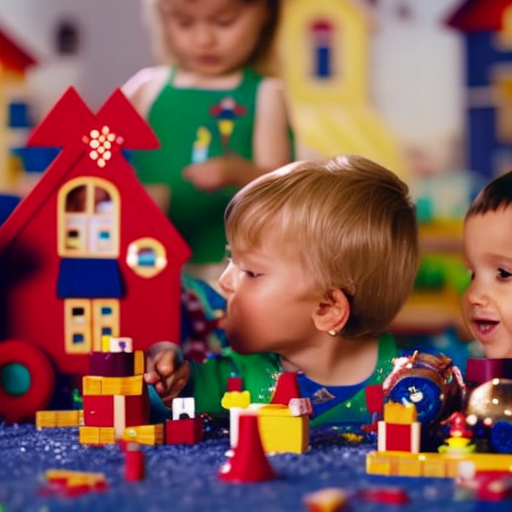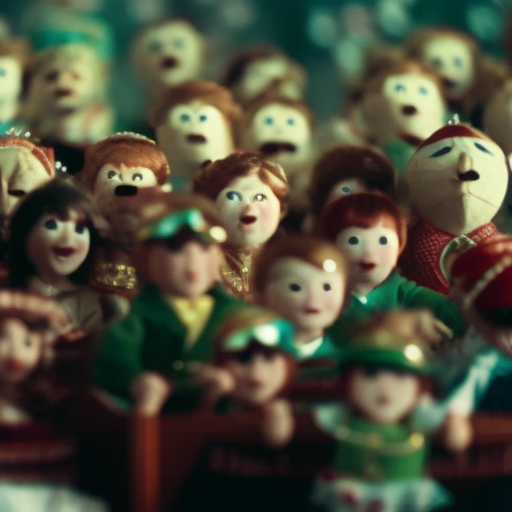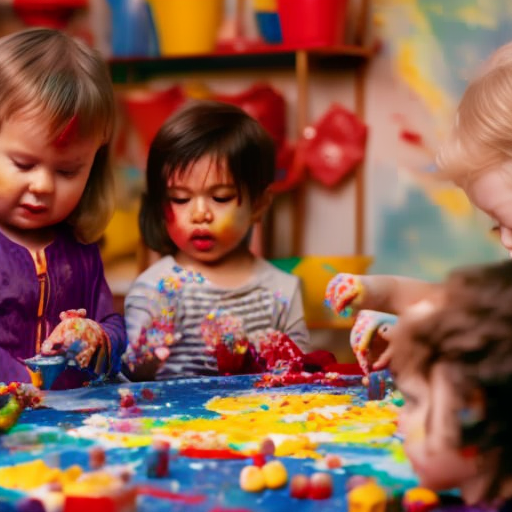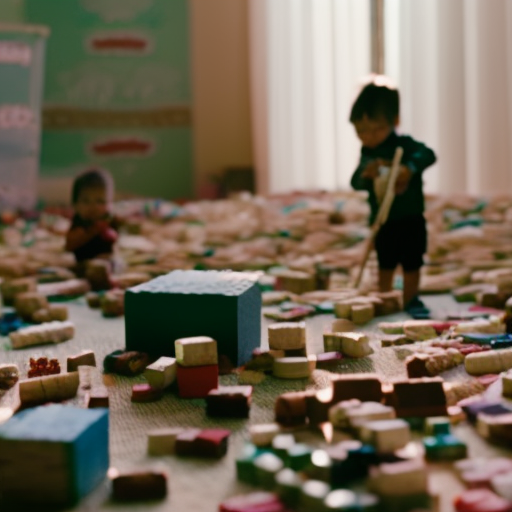"Cherishing Little Steps - A Haven for Baby and Family Journeys"
Building Imagination in Preschoolers
In a world where screens dominate and instant entertainment is at the touch of a button, it’s easy for preschoolers to lose touch with their imagination, that magical realm where anything is possible. But fear not, for there are ways to reignite that spark and help your little ones embark on fantastical adventures within the confines of their own minds.
By tapping into the power of imaginative play, creating a stimulating environment, and incorporating various activities that encourage storytelling and role-playing, you can unlock a world of endless possibilities for your preschooler.
But how exactly can you go about building their imagination? Let’s explore some strategies that will help your child unleash their creativity and discover a world beyond what meets the eye.
Key Takeaways
- Imaginative play boosts cognitive development.
- Creating a stimulating environment with toys and props sparks imagination.
- Storytelling and role-playing develop language skills and creativity.
- Art and craft activities stimulate sensory exploration and fine motor skills.
Benefits of Imaginative Play

Discover the incredible benefits that imaginative play brings to your preschooler’s development! The power of pretend isn’t just a game; it’s a stepping stone towards boosting cognitive development. When your little one engages in imaginative play, their brain is working overtime, making connections and firing up those neurons. It’s like a mental workout where they get to flex their creativity and problem-solving skills.
Through imaginative play, your child learns to think outside the box, to come up with solutions to imaginary problems, and to see the world from different perspectives. They become little actors, directors, and storytellers, creating their own narratives and exploring endless possibilities. This kind of play stimulates their imagination, allowing them to dream big and develop a sense of wonder about the world around them.
As they immerse themselves in make-believe scenarios, they learn how to negotiate, cooperate, and communicate effectively with others. They take on different roles, empathize with their playmates, and develop social skills that are vital for future friendships and relationships.
The power of pretend even extends to their emotional well-being, as it provides an outlet for self-expression and helps them process their feelings in a safe and imaginative way.
Creating a Stimulating Environment

Now let’s dive into the exciting world of creating a stimulating environment for your little one’s imaginative play! To foster your child’s imagination, it’s important to provide them with a space that encourages sensory exploration and outdoor adventures.
Start by setting up a designated area for imaginative play. This could be a cozy corner in their bedroom or a dedicated space in the living room. Fill it with a variety of toys and props that spark their imagination, such as dress-up clothes, puppets, and building blocks.
Additionally, consider incorporating open-ended materials like playdough, sand, or water tables to provide opportunities for sensory exploration.
Outdoor adventures are a great way to stimulate your child’s imagination. Create a backyard oasis by setting up a playhouse or fort where they can embark on imaginative journeys. Add in natural elements like rocks, sticks, and flowers to inspire their creativity.
Take them on nature walks or picnics in the park to expose them to different environments and encourage their curiosity.
Encouraging Storytelling and Role-Playing

To ignite your child’s imagination, encourage storytelling and role-playing through interactive and imaginative play experiences. These activities not only provide endless fun, but also play a crucial role in developing language skills and fostering creativity.
Storytelling allows your child to weave their own narratives and bring characters to life. It helps them build vocabulary, improve their communication skills, and develop a deeper understanding of emotions and relationships. Encourage your child to create stories using their favorite toys or even everyday objects as props. Provide them with open-ended prompts or ask them questions to spark their imagination. Let them take the lead and watch as their stories unfold.
Role-playing, on the other hand, allows your child to step into different roles and explore various scenarios. Whether they pretend to be a doctor, a chef, or a superhero, role-playing encourages creativity, problem-solving, and empathy. Provide them with dress-up clothes, pretend play sets, and props to enhance their play experience. Join in the fun and take on different roles yourself to deepen their engagement.
Incorporating Art and Craft Activities

As your child’s imagination continues to flourish through storytelling and role-playing, it’s time to explore the world of art and craft activities. Engaging your preschooler in sensory exploration and fine motor skills development through art and craft activities can further enhance their imaginative abilities.
Art and craft activities provide a hands-on experience that allows your child to explore different textures, colors, and materials. This sensory exploration stimulates their senses and helps them develop a deeper understanding of the world around them. Encourage your child to touch, feel, and experiment with various art supplies such as paint, clay, and collage materials.
In addition to sensory exploration, art and craft activities also promote the development of fine motor skills. The intricate movements required to hold a paintbrush, cut with scissors, and manipulate small objects help strengthen your child’s hand-eye coordination and dexterity. These skills are essential for tasks such as writing, tying shoelaces, and buttoning clothes.
To engage your child in art and craft activities, you can try the following ideas:
| Activity | Materials Needed | Benefits |
|---|---|---|
| Finger painting | Non-toxic paint, paper | Promotes sensory exploration and fine motor skills development. |
| Collage making | Various materials such as colored paper, magazines, glue | Encourages creativity and fine motor skills development. |
| Playdough sculpting | Playdough, small tools like plastic knives and cookie cutters | Enhances sensory exploration and fine motor skills development. |
Incorporating art and craft activities into your child’s daily routine not only allows them to express their creativity but also supports their overall cognitive and physical development. So, grab some art supplies and dive into the colorful world of imagination with your little one!
Engaging in Open-Ended Play Prompts

Let’s get ready to unleash your child’s imagination with some exciting open-ended play prompts! Creative exploration and playful inspiration are key to fostering imaginative thinking and problem-solving skills in preschoolers. Open-ended play prompts provide endless possibilities for your child to explore, create, and imagine.
One way to engage in open-ended play is by setting up a sensory bin. Fill a large container with rice, sand, or water and add various objects like scoops, funnels, and toy animals. Encourage your child to explore and manipulate the materials, creating their own stories and scenarios. This type of play not only stimulates their senses but also promotes fine motor skills and imaginative thinking.
Another idea is to create a dress-up corner. Fill a box with hats, scarves, and costumes, and let your child’s imagination take flight as they transform into different characters. You can join in the fun too, taking on different roles and engaging in pretend play together. This type of play allows your child to explore different perspectives, emotions, and social dynamics.
Lastly, building blocks and construction sets provide endless opportunities for creative exploration. Encourage your child to build towers, bridges, or even imaginary worlds. As they experiment with different structures and designs, they develop problem-solving skills and spatial awareness.
Frequently Asked Questions
How Does Imaginative Play Benefit a Child’s Cognitive Development?
Imaginative play helps your child’s cognitive development by enhancing problem-solving skills and fostering creativity. It also plays a crucial role in their social development, as they learn to communicate and cooperate with others in their imaginative worlds.
What Are Some Examples of Open-Ended Play Prompts That Can Be Used to Foster Imagination in Preschoolers?
You can spark your preschooler’s imagination with open-ended play prompts. Try creative play ideas like building forts or creating a pretend restaurant. Through art and craft activities, storytelling, and role playing, you’ll foster their imagination, enhance their language skills, and create a stimulating environment.
How Can Parents Create a Stimulating Environment at Home to Encourage Imaginative Play?
To create a stimulating environment at home for imaginative play, you can create imaginative play spaces that incorporate nature. Set up a cozy reading nook or a pretend play area with natural materials like branches, leaves, and rocks. Let their imagination run wild!
What Are Some Art and Craft Activities That Can Help Enhance a Child’s Imagination?
"Get ready to unleash your child’s imagination with a variety of art and craft activities! From painting and sculpting to sensory play with playdough and collage making, these artistic expressions will ignite their creativity."
How Can Storytelling and Role-Playing Activities Enhance a Child’s Language and Communication Skills?
Storytelling and role-playing are essential for preschoolers’ language and communication skills. Pretend play helps them develop vocabulary, express their thoughts, and understand different perspectives. Through storytelling, they learn to communicate effectively and engage their imagination.
Conclusion
So, as you can see, building imagination in preschoolers isn’t only important but also incredibly fun!
By providing a stimulating environment, encouraging storytelling and role-playing, incorporating art and craft activities, and engaging in open-ended play prompts, you’re helping your little ones develop their creativity and problem-solving skills.
So go ahead, let their imaginations soar and watch as their minds and spirits grow in ways you never imagined!
It’s a journey filled with magical surprises and endless possibilities.
Let the adventure begin!


